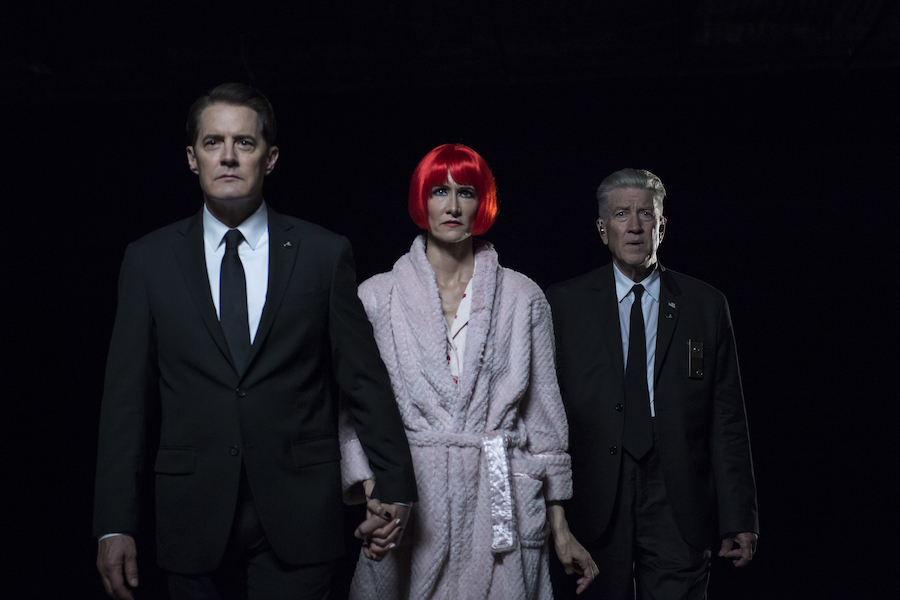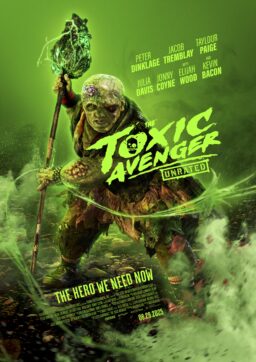We are pleased to offer an excerpt from the December issue of the online magazine, Bright Wall/Dark Room. The theme of for December issue is “Best of the Decade” and, in addition to this “Twin Peaks” piece by Calvin McMillin, also features new essays on “The Florida Project,” “The Tree of Life,” “It Follows,” “Beginners” / “20th Century Women,” “Nathan For You,” “Force Majeure,” “Sleeping with Other People,” “The Counselor,” “The Immigrant,” “The Comedy” and their editorial staff lists & thoughts on the best films of the decade.
You can read our previous excerpts from the magazine by clicking here. To subscribe to Bright Wall/Dark Room, or look at their most recent essays, click here.
“How does it end?” my mother asks.
“What? Don’t you want to find out what happens for yourself?”
“No.”
II
When I visit my mother in rural Oklahoma, we’ll often watch movies and TV shows together. Whether we’re taking in the latest Hollywood blockbuster, a recent Korean drama, or an old-school Hong Kong action flick, she’ll invariably ask me the same question: “How does it end?” The matter of whether I’ve actually seen the film or episode is of no concern to her. She just wants answers.
In the last few years, my mom has also fallen into the habit of watching Hallmark Christmas movies—about as far a cry as possible from my preferred comfort viewing, Twin Peaks. Of course, she never asks me how these Hallmark movies end because there’s really no need. They all share the same ending—“And they all lived happily ever after.” In their own way, these holiday films provide my mom with a small measure of comfort. Certain narratives can be too stressful for her, so whatever spoilers I can grudgingly reveal give her a much-needed sense of relief. If I tell my mother that the heroes make it to the end, then she can breathe a little easier. If she knows in advance that they don’t, then she can be emotionally prepared when their appointed time comes.
Perhaps all of this sounds rather silly. But it’s really a matter of perspective. Several years ago, my family received a horrible shock when my father was diagnosed with cancer. My mom, after years of working as a nurse and attending to the needs of strangers, had no choice but to retire so she could care for my dad. Now that he’s gone, my mother lives alone in a small town—not quite Twin Peaks, but close enough. And with each passing year, it seems like so many of her neighbors, friends, and family members are getting sick, dying, or both. So I suppose there’s a certain logic at work in her unconventional embrace of spoilers—life is full of so much actual stress and honest-to-god tragedy, why suffer even a moment of mental anguish over a piece of fiction?
While I understand her point of view, I don’t subscribe to it. I’m not the kind of person who combs discussion forums looking for plot spoilers or script leaks. Personally, I prefer to know very little in advance so I can lose myself in the story, just as the artist intended. If the resultant experience can provide me with a feeling of escape or some necessary distraction from the horrors of real life, so be it. But I also don’t shy away from art that challenges me, even if it threatens to pierce me where I know I am most vulnerable. It’s a risk, but if I’m lucky, I just might experience a measure of solace, catharsis, or even illumination. This was true before the arrival of Twin Peaks: The Return, and it has remained true ever since.
One thing that the show did change was my attitude toward endings. As any Twin Peaks fan will tell you, the wait between Sundays during the summer of 2017 was excruciating. While watching the show, I often found myself looking at my watch, not out of boredom, but out of fear. I didn’t want any of the episodes to end. Of course, almost every time the show cut to a musical interlude at the Roadhouse, I knew that my time in the land of Twin Peaks was nearing completion.
So with each passing week, I’d wonder the same question with an increasing sense of urgency—
How does it end?
III
The original ABC run of Twin Peaks ended on a polarizing cliffhanger, one that initially plays out like a fairytale. At the conclusion of season two, Special Agent Dale Cooper (Kyle MacLachlan), ventures into the Black Lodge to save the life of his love interest, Annie Blackburn (Heather Graham). After a nightmarish journey into the underworld, Cooper returns to the land of the living, saving the girl and winning the day. Or so it seems.
The episode’s infamous final scene reveals that Cooper is not quite himself—in truth, he’s literally not himself. The Cooper who emerged from the Black Lodge is a doppelgänger, one inhabited by the show’s primary antagonist, an evil entity known as BOB (Frank Silva). The episode ends with Cooper’s dark twin cackling in front of a shattered bathroom mirror, repeatedly asking “How’s Annie?” as the credits roll.
Contrary to popular opinion, this ending was not necessarily David Lynch’s middle finger to the audience. It was, at least according to star Kyle MacLachlan, a cliffhanger designed to maximize interest in the show and hasten its renewal. As he told Brad Dukes in the 2014 book Reflections: An Oral History of Twin Peaks, “I felt like we were attempting to regenerate something that would possibly motivate the network to give the show another chance.” Unfortunately, the executives at ABC felt differently, and the show was canceled a month after it wrapped production.
And yet, Twin Peaks would not die. Disheartened by the show’s unceremonious ending, David Lynch enlisted the help of writer Robert Engels for a 1992 follow-up—the heartbreaking, widely misunderstood Twin Peaks: Fire Walk with Me. Although technically a prequel, the film plays with notions of time and space; at one point, a spectral Annie Blackburn tells the soon-to-be-murdered Laura Palmer (Sheryl Lee) that the “Good Dale is in the Lodge,” suggesting the possibility of a resolution to the season two cliffhanger. In Chris Rodley’s 2005 book Lynch on Lynch, the notoriously tight-lipped director spoke at length about the Laura-Annie scene, ultimately lamenting that he “had hopes of something coming out of that.” Whatever Lynch’s aspirations were at the time, it mattered little. Fire Walk with Me was a critical and commercial failure, effectively killing the series once more. Although the cult of fans only grew in the intervening years, Twin Peaks—as a show, as a potential film series, as anything at all—was over.
Until it wasn’t.
In a shocking twist worthy of the show itself, series co-creators David Lynch and Mark Frost resuscitated Twin Peaks from a more than two-decades-long coma. However, the path to the premiere of Twin Peaks: The Return was full of fits and starts. Showtime announced a nine-episode miniseries in October 2014, only to have Lynch leave over a financial dispute the following April and then return to the project in May, this time with the desired budget and an expanded 18-episode season. After so many disappointments, the fans could finally breathe a sigh of relief. And with Lynch back at the helm, the possibility a more definitive ending to Twin Peaks was no longer the stuff of dreams.
How could we be so naive?
IV
Twin Peaks: The Return was, without question, the most satisfying television experience of my adult life. I can recognize how my use of the word “satisfying” might sound a bit tongue-in-cheek, considering the unsettling, open-ended nature of the final episode; even before the finale aired, the show had already tested the patience of new and longtime viewers alike. The extended silences, the languorous pacing, and the surprising lack of Special Agent Dale Cooper operating at his full capacities likely caused some viewers to drop the show, if not their Showtime subscriptions. Others simply waited, possibly with gritted teeth, hoping that the revival would eventually transform into something that more closely resembled their memories of the original series. Thankfully, Lynch and Frost had other ideas, and the results were brilliant, beautiful, and pretty damn weird.
One of the most instructive anecdotes about the show’s production comes from Jim Belushi, who makes up one half of the hilarious Mitchum brothers alongside Robert Knepper. In an interview with Entertainment Weekly, Belushi admitted, “I had to adjust my rhythm, and it started out with a cup of coffee…I poured a cup of coffee and started my line and [Lynch] went, ‘No. Nooooo. The coffee is very important.’ I spent 20 seconds pouring and sipping on a cup of coffee before I even started the scene.”
Whether showcasing Bradley Mitchum’s—or frankly any other character’s—delight in a damn good cup of coffee or simply holding a particular scene a bit longer than “normal,” Twin Peaks: The Return is all about savoring the little moments in our lives. Watching these scenes is no doubt a frustrating experience for viewers unfamiliar with Lynch’s work, but there is a method in his madness. Eschewing explanation in both his art and the critical conversation that surrounds it, Lynch strikes me as a man more interested in discovery—both for the audience in their experience of his work and for himself in the act of creation. After all, what is Cooper’s “Dougie Jones” arc but a celebration of the fundamental joys of rediscovering the world with pure, childlike wonder?
“Savoring the moment” is an apt philosophy for a series so preoccupied with life’s impermanence. While the series’ primary antagonist, the supernatural doppelgänger Mr. C (Kyle MacLachlan again), leaves numerous corpses in his wake, the specter of death haunts the show in less fantastical ways. Several major and minor Twin Peaks characters have been diagnosed with terminal illnesses, the son of Sheriff Frank Truman (Robert Forster) has committed suicide prior to the events of the series, and an innocent child dies right before our eyes in a senseless hit-and-run collision. These and other personal tragedies, many inconsequential to the main plot, emphasize not just the tragic fates of the dead and the dying but the undue emotional and psychological burden placed on their grief-stricken loved ones. “How does it end?” suddenly becomes a much more serious existential question.
In the show, grief also operates on a metatextual level. As the many “In Memory Of” credits remind us, the sheer number of departed Twin Peaks cast members is staggering. David Bowie, Catherine E. Coulson, Don S. Davis, Miguel Ferrer, Warren Frost, Frank Silva, and so many more have left us, and their (re)appearance—some with flesh-and-blood performances, others through archival footage and CGI—forces the viewer to confront death in ways that no other scripted television show, past or present, ever has. And with the subsequent deaths of other cast members—most notably, Harry Dean Stanton, Peggy Lipton, and Robert Forster—the impact of the show’s fixation on mourning only accrues with each passing year. Of course, that’s the fate of all movies and television programs—they become de facto memorials where actors live on long after their real-life demises. However, in both tone and theme, the focus on death in Twin Peaks: The Return feels more explicitly confrontational.
I’ve watched Twin Peaks: The Return countless times since its initial broadcast, and yet I am discovering new things with each revisit. During my most recent viewing, one relatively minor scene proved doubly heartbreaking. In episode seven, Sheriff Frank Truman calls his brother Harry to ask a few questions and inform him about new developments in the Laura Palmer case. Deputy Hawk (Michael Horse) has discovered missing pages from Laura’s diary that not only mention Agent Cooper—a person she could not have possibly met—but also indicates the existence of two Coopers, a clear reference to the Annie-Laura scene in Fire Walk with Me. In the molasses-paced world of late-period David Lynch, this is an exhilarating moment, one that suggests the long-awaited convergence of disparate storylines, some left dangling from both season two and Lynch’s much-maligned prequel. However, Lynch and Frost once again elect to subvert the audience’s expectations.
In the first two seasons of Twin Peaks, Michael Ontkean played Sheriff Harry S. Truman, and the scene deals directly with the actor’s conspicuous absence. In the context of the episode, Frank intends to share an earth-shattering revelation with Harry, but it is instead he who finds his entire world thrown into disarray. The precise moment Frank realizes that his younger brother is far sicker than he let on, any discussion of Laura Palmer, Agent Cooper, or the Black Lodge goes right out the window. In comparison to Harry’s failing health, these otherworldly mysteries suddenly feel small and unimportant. Forster exudes a quiet energy in all his scenes, but here his character struggles to remain calm, despite the devastating news. Forster’s final line in the scene—“Harry, do me a favor: Beat this thing”—was poignant when it first aired, but even more so now, as Forster would die of brain cancer two years later. For a television show so obviously obsessed with doppelgängers and death, the uncanny doubling of both reality and fiction feels particularly apropos.
To tell you the truth, the bitter irony of that scene isn’t the only thing that gets to me—it’s Frank himself, as embodied by Robert Forster. Looking at him, I can’t help but think of my own father. Like the fictional Truman brothers, he was a man of integrity, strength, and quiet sensitivity. My dad was that increasingly rare commodity in our modern world—a good man.
Nine years ago, my father finally decided to retire. After a lifetime of hard work, he planned on taking a long overdue vacation with my mom and fly overseas for the first time in three decades. He also expressed a desire to spend more quality time with me when I visited in the summers, so he started repairing an old boat with the intention of taking me fishing. On top of that, my dad was eagerly anticipating my graduation the following year, partly because he was proud and partly because he’d finally be able to call me “Doc.” Beyond that, there were even bigger dreams I had hoped he’d see me achieve.
None of that happened.
In the summer of 2010, my father was diagnosed with leukemia. Six months later, he would die in a hospital bed. In the movies, characters on the verge of death often get to say their final goodbyes, perhaps even imparting one final bit of wisdom to their loved ones. In real life, my father passed away without a word—right before my eyes. In that moment, to paraphrase Dashiell Hammett, I felt like somebody had taken the lid off life and let me see the works.
“How does it end?” you might ask. I can tell you the answer—
In tears.
V
As I watched Twin Peaks: The Return each week, I couldn’t help but recall the words of Russian filmmaker Andrei Tarkovsky: “The aim of art is to prepare a person for death, to plough and harrow his soul, rendering it capable of turning to good.” As numerous characters face their impending demises, Twin Peaks: The Return seems to ask, “Is there still time to turn toward the good?”
The show addresses this question in many ways, not least through its obsession with duality—one made literal by a plethora of doppelgängers, most notably Mr. C and the tulpa version of Diane Evans (Laura Dern). Even so, this binary of good and evil is not as clear-cut as it seems. Not only does the “bad” Diane struggle with divided loyalties (her scream of “I’m not me!” is raw, unsettling, and oddly relatable), but the “good” Cooper becomes an ambiguous figure in Part 18, existing somewhere between the darkness and the light.
This notion of a divided self is not strictly limited to doppelgängers either. When the slimy insurance agent Anthony Sinclair (Tom Sizemore) fails in his attempt to poison Cooper-as-Dougie, he suffers a complete mental breakdown. Confessing his sins to his boss (Don Murray), Sinclair cries out, “I only want to die or change!” Viewers at least obliquely aware of Sizemore’s troubled history may see an added dimension to the actor’s performance, but even if we take the scene on its own merits, there remains something undeniably powerful about watching a relatively insignificant sleazebag repent and beg for forgiveness. With Sizemore’s character and so many others throughout the series, one can hear echoes of the old Turkish proverb: “No matter how far you’ve gone down the wrong road, turn back.” Death looms large over the proceedings—but in the world of Twin Peaks, positive change is still possible.
VI
Part of the reason I, and so many others, fell in love with the original Twin Peaks—beyond the charismatic decency of Dale Cooper, the hypnotic soundtrack, and the eclectic mishmash of genres—is the idea of a sleepy Mayberry-like community that holds dark, disturbing secrets. As David Foster Wallace once wrote about Lynch’s work, “Darkness is in everything, all the time—not ‘lurking below’ or ‘lying in wait’ or hovering on the horizon.’” Light and darkness coexist, and we see that explicitly within the bounds of Twin Peaks itself, where a no-nonsense trailer park manager (Harry Dean Stanton) can bring comfort and aid to people in deep distress while a disgusting, ponytailed trucker (John Paulsen) can sexually harass and physically threaten Sarah Palmer (Grace Zabriskie) as she drinks alone in a bar. Both men make up the fabric of the town, and the duality they represent exists in our communities, in our families, and—as David Lynch would seem to suggest—even in ourselves.
Certainly, our current political climate has made the darkness in others impossible to ignore—it was bleak when Twin Peaks: The Return premiered in 2017; it seems only bleaker now. At times, the sheer futility of it all can be overwhelming. But in a world seemingly being flushed down the toilet, perhaps the show’s resident quack Dr. Lawrence Jacoby (Russ Tamblyn) actually got something right. In the intervening years, the eccentric psychiatrist refashioned himself into a late-night shock jock, and his conspiracy theorist alter-ego “Dr. Amp” claims to have the prescription for what ails us all: “Shovel your way out of the shit.”
Admittedly, the show undercuts the significance of Jacoby’s catchphrase through its inclusion in a late-night infomercial peddling a “gold shit-digging shovel” for the low, low price of $29.99 (plus S&H). Leaving aside the crass hucksterism of the ad, this throwaway joke is the perfect tool for digging into the show’s divisive, nigh-impenetrable ending.
In Part 18, Dale Cooper tracks down a very much alive version of Laura Palmer, now an Odessa waitress named Carrie Page. Although she has no recollection of her former life, Cooper convinces her to accompany him on the long drive back to Twin Peaks. Upon arrival, he immediately takes Carrie to the Palmer home in the hopes that it will jog her memory. Whatever Cooper’s intentions, a heartwarming mother-daughter reunion seems highly unlikely, due to the not-so-small matter of Sarah Palmer’s demonic possession.
While nothing is explicitly spelled out for the viewer, both Twin Peaks: The Return and Mark Frost’s 2017 companion book Twin Peaks: The Final Dossier strongly suggest that Sarah may be inhabited by “Jouday” (or Judy), an ancient evil that feeds on “garmonbozia,” a concept introduced in Fire Walk with Me referring to pain and sorrow. So what exactly Cooper expected to happen during this meeting has become the subject of much fan debate. Regardless, at the Palmer home, nothing goes as planned, if there even is a plan: Sarah is nowhere to be found. The house is now owned by a woman named Alice Tremond (Mary Reber, the real-life owner of the house), who claims to have bought it from Mrs. Chalfont. For Cooper, Carrie, and quite possibly the viewer, the encounter is as baffling as it is anticlimactic.
Walking back to the car, Cooper is left to ask aloud, “What year is this?”—suggesting a critical miscalculation in his interdimensional journey. However, before he can even process this surprising reversal of fortune, the disembodied voice of Sarah Palmer utters the name “Laura,” causing Carrie Page to look back at the Palmer home. The show—and quite possibly the series—ends with actress Sheryl Lee’s iconic, terrifying scream, as the house lights go out and the screen cuts to black. This is most assuredly not a Hallmark Channel-approved fairytale ending.
Essentially, the episode concludes with yet another cliffhanger, and its ambiguity has only sparked further debates and fervert theorizations among the Twin Peaks faithful. But in my estimation, the question of whether Cooper has found himself trapped in a pocket universe, a reconstituted timeline, or yet another Lynchian dreamscape is far less important than what our hero might do the moment he regains his bearings.
Darkness does indeed seem to be in everything all the time—not just in Lynch’s narratives, but in our world as well. Looking at the horrors of the 24-hour news cycle, one cannot help but feel despair, a creeping sense of futility, and above all exhaustion. If poet Dylan Thomas had lived to see the 2010s, perhaps he would forgive us if we ignored his advice and chose to “go gentle into that good night.”
In a 1992 interview with Kristine McKenna, David Lynch revealed that “the downhill spiral into chaos” was the aspect of the future he found most disturbing:
We’re in a time when you can really picture these really tall evil things running at night, just racing. The more freedom you give them, the more they come out and just race and they’re running in every direction now. Pretty soon there’ll be so many of them that you can’t stop them. It’s really a critical time.
Undoubtedly, the final seconds of Part 18 are a critical time for Agent Cooper, too. By the end of Twin Peaks: The Return, it’s almost painful to see him in such a state of obvious distress. And yet, if we know anything about the character at all, it’s this—Cooper may be down, but he’s not out. Not yet anyway. Not after a routine FBI investigation that turned into a metaphysical odyssey that lasted 25 years. Not after escaping the limbo of the Red Room only to find himself relearning his fine motor skills and bringing joy to the family of a hapless insurance agent. And certainly not after vanquishing both his evil doppelgänger and the malevolent entity known as BOB—all with a little help from his friends.
Yes, Cooper may have lost this battle, just as he might lose many more in his personal war against the all-engulfing darkness—call it “Judy,” call it “BOB,” call it “the shit,” call it whatever name you like. But as Mark Frost once remarked in a Reddit AMA, “If and when evil presents itself—regardless of its origin—resistance is necessary.” So as harrowing as Cooper’s plight may seem during the episode’s closing moments, the truth is we don’t actually need another season of Twin Peaks to guess what will happen next. In our hearts, we know that Cooper won’t give up. He won’t back down. He’ll grab a metaphorical gold shovel and dig his way out of this mess. He’ll just keep on fighting—to the very end.
And so should we.











